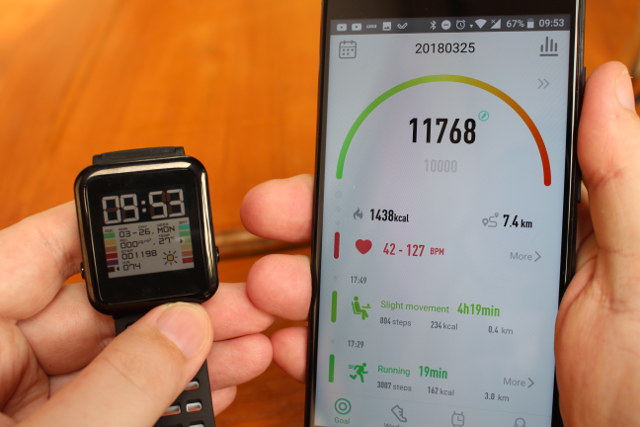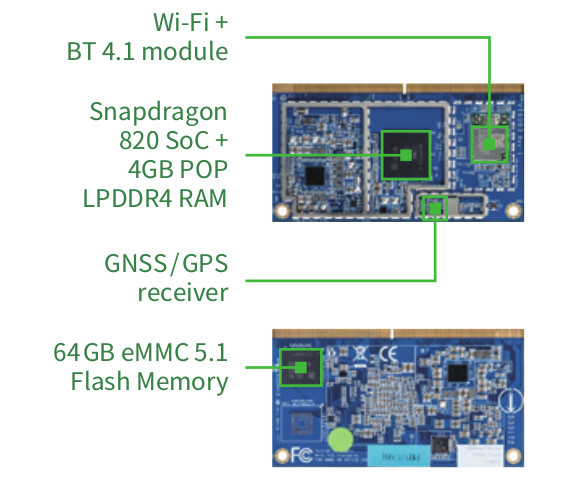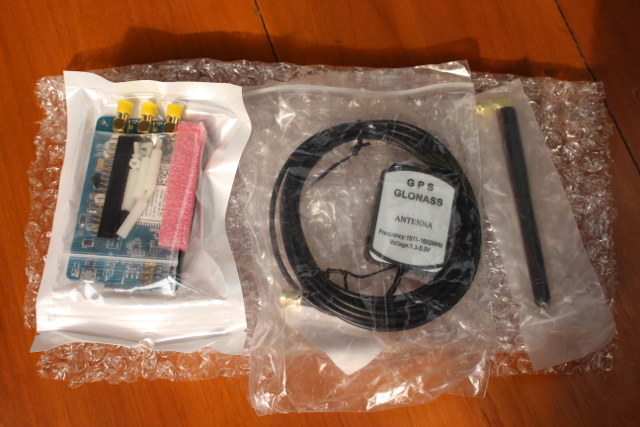Rak Wireless has recently launched a new products called RAK8211-NB iTracker based on a Quectel BC95-G NB-IoT module, Nordic Semi nRF52832 Bluetooth 5 chip, and Quectel L70-R GNSS module. The asset tracker module also comes with 5 different sensors to monitor motion and environmental data, and can optionally be powered directly by a solar panel.RAK8211-NB iTracker specifications: Connectivity NB-IoT via Quectel BC95-G (Global) wireless communication module + SIM card socket Bluetooth 5 via Nordic Semi nRF52832 Arm Cortex-M4F micro-controller (Arduino compatible) GPS/GLONASS via Quectel L70 GNSS module Sensors LIS3DH 3-axis “nano” accelerometer LIS2MDL 3-axis digital magnetic sensor. Tilt sensor BME280 pressure, humidity and temperature sensor OPT3001 intensity of light sensor Expansion – 3x headers with SWD, 2x sensor out + tilt out (also usable as GPIO and analog inputs), 3.3V, GND, and reset Power Supply – 3.5V to 18V via solar panel (P2) or battery (P3) Dimensions – 43mm x […]
WeLoop Hey 3S Sports Smartwatch Review – Part 2: GPS, Running, Cycling, Notifications, and More
As mentioned previously I did not have such good luck with smart wearables so far, with disappointing products often with a short lifetime (a few weeks to a few months, and some design issues here and there like an e-Paper display without backlight, a touchscreen display with poor locking mechanism (so it’s activated while taking a shower), unreliable heart rate monitor, poor waterproofness and so on… My main requirements are always-on display, battery life as long as possible, notification support, good waterproofness to do tasks like taking shower or swim without having to remember to remove the watch, among others less important requirements. I mostly gave up on the category for about year, but decided to give it a try when GeekBuying asked me if I was interested in reviewing WeLoop Hey 3S sports smartwatch. Maybe things have improved since then. I’ve already gone through unboxing and initial setup in […]
VIA SOM-9X20 Module Powers Smart Recognition and Smart Machine Vision Platforms
At the end of last year, VIA launched SOM-9X20 system-on-module powered by Qualcomm Snapdragon 820 processor coupled with 4GB PoP LPDDR4 RAM, 64 GB eMMC flash, as well as WiFi + Bluetooth module, and a GNSS/GPS receiver. The company introduced two software platform for the SoM and development kit at embedded world 2018: a Smart Machine Vision Platform for manufacturing management and control systems, and a Smart Recognition Platform for facial recognition, object detection, people counting & tracking, etc… VIA SOM-9X20 module specifications: SoC – Qualcomm Snapdragon 820 quad- core processor with 2x high-performance Kryo cores up to 2.15GHz, 2x low power Kryo cores up to 1.593GHz, and Adreno 530 GPU supporting OpenGL ES 3.1/ GEP, GL4.4, DX11.3/ 4, OpenCL 2.0, Renderscript-Next System Memory – 4 GB POP LPDDR4 RAM Storage – 64 GB eMMC 5.1/ UFS 2.0 flash On-module Connectivity Wi-Fi 802.11 a/ b/ g/ n/ ac + Bluetooth […]
Avnet Silica NB-IoT Sensor Shield Works with mbed OS 5, STM32 Nucleo Board
If for some reasons, none of the many NB-IoT boards launched recently suit your needs, there’s yet another option with Avnet Silica NB-IoT sensor shield, that supports – despite the name – also supports LTE Cat M1 (eMTC) beside NB-IoT (LTE Cat NB1), and comes with Arduino headers, as well as a Pmod connector. The board relies on Quectel BG96 module, and can be controlled with Arm mbed OS 5 when connected to STM32 Nucleo board. NB-IoT Sensor Shield specifications: Cellular Module – Quectel BG96 LPWA Module Multi Modes: Cat.M1, Cat.NB1, EGPRS Global bands Cat M1/NB1: B1 B2 B3 B4 B5 B8 B12 B13 B18 B19 B20 B26 B28 B39 (B39 for Cat M1 only) EGPRS: 850/900/1800/1900 MHz Voice Over LTE support (M1 only) – PCM digital audio interface SIM card holder (also optional embedded SIM) Optional GNSS – GPS, GLONASS, BeiDou/Compass, Galileo, QZSS Expansion – Arduino headers, Pmod connector […]
SODAQ SARA is an Arduino Compatible Cellular IoT Board with LTE-M, NB-IoT, and GNSS (Crowdfunding)
There really seems to be a push for cellular IoT those days, with new hardware coming up every week. Following up on their NB-IoT shield for Arduino last year, SODAQ has now launched two versions of SARA boards based on u-blox SARA LTE-IoT modules, and u-blox M8Q GPS/GNSS module. Both boards are Arduino compatible thanks to a Microchip SAMD21 MCU, and while u-blox SARA board follows the Arduino form factor, u-box SARA SFF is much more compact (50×25.4 mm) and potentially easier to integrate into a project or product. Another pretty unique feature (AFAICT) is that you can power the board directly with a solar panel. u-blox SARA board specifications: Wireless module (three options) with external antenna: SARA-N211 NB-IoT, band 8 and 20, for the European and African market SARA-R410M Dual mode LTE-M and NB-IoT module for all global bands SARA-R412M Triple mode module with LTE-M, NB-IoT and 2G for […]
How to Use 3G and GPS on Raspberry Pi with ThaiEasyElec 3G HAT Expansion Board
Venus Supply is an embedded systems company based in Bangkok, Thailand that sells products through their ThaiEasyElec website/brand, as well as a act as a local distributor for popular DIY electronics items. I previously tested their ESPino32 ESP32 board, and the company has now send me another of their new product called “3G HAT Expansion for Raspberry Pi” and based on Quectel UC20-G that support 3G and GPS/GLONASS connectivity globally, meaning it should work in any country with 2G or 3G coverage. After listing the specifications, going through unboxing and assembly with a Raspberry Pi 2/3 board, I’ll write some quick start guide to show what I had to do to use GPS and connect to 3G with a Hologram SIM card. 3G HAT Expansion for Raspberry Pi Specifications Quectel UC20-G wireless module supporting Cellular 3G – UMTS @ 800/850/900/1900/2100 MHz 2G – GSM @ 850/900/1800/1900 MHz Data – HSPA+ […]
TECHBASE ModBerry M300 IoT Gateway Adds Support for NanoPi and Orange Pi Allwinner H5 Boards
Announced at the end of last year TECHBASE launched the ModBerry M300, a Linux IoT gateway powered by FriendlyELEC NanoPi NEO board equipped with Allwinner H3 Cortex A7 processor. The company has now made four extra variants of the gateway with Allwinner H5 quad core Cortex A53 based development boards from FriendlyELEC and Shenzhen Xunlong: Modberry M300 N2 – Based on NanoPi NEO2 Modberry M300 N2+ – Based on NanoPi NEO Plus2 adding 8GB eMMC flash, WiFi & Bluetooth 4.0, and an extra USB port over the N2 model Modberry M300 O1 – Based on Orange Pi Zero Plus Modberry M300 O2 – Based on Orange Pi Zero Plus2 adding 8GB eMMC flash, HDMI, one extra USB port, and Bluetooth 4.0 over the O1 model, but falling back to 10/100 Ethernet, while all three models above come with Gigabit Ethernet To avoid confusion, the original NanoPi NEO model has changed […]
Nordic nRF91 Multimode LTE-M / NB-IoT SiP Embeds Arm Cortex-M33, Arm TrustZone, and Assisted GPS
Nordic Semi will soon launch nRF91 series low power cellular IoT solution, that consists of a system-in-package (SiP) combining a global multimode LTE-M / NB-IoT modem, an Arm Cortex-M33 core, Arm TrustZone security solution, assisted GPS, and flash memory into a 16x10x1.2 mm package. Nordic Semi nRF91 specifications known to far: CPU – Arm Cortex-M33 ARMv8-M host processor Memory / Storage – Built-in RAM and flash Memory Connectivity Multimode LTE-M (eMTC) and NB-IoT modem by Nordic SAW-less transceiver Custom RF front-end solution from Qorvo. Location – Optional assisted GPS combining cellular and GPS technology for fast and accurate positioning Security – Arm TrustZone security via Arm CryptoCell-310 security IP Power Management Package – 16 x 10 x 1.2 mm Nordic Semiconductor nRF91 Series is said to include a complete suite of software and development tools for product development, but no details were provided at this stage. The solution has already […]









